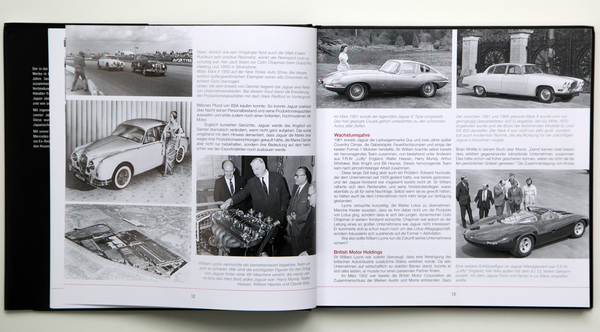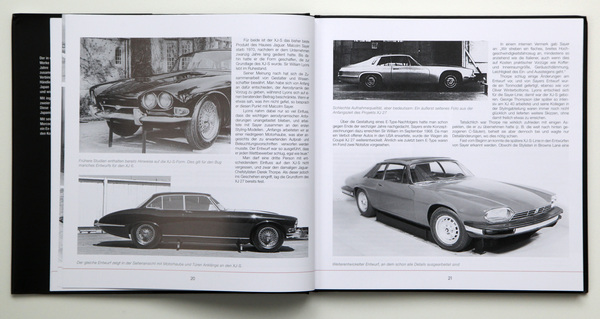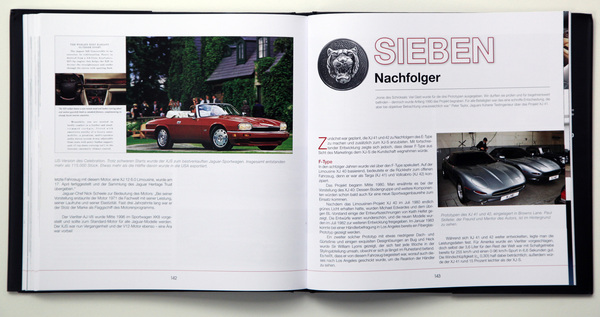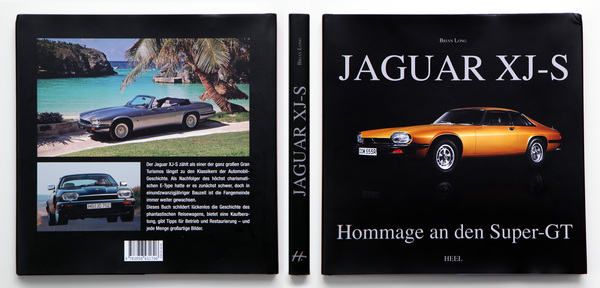In the swinging sixties, it seemed easy to make everything just that little bit better. While NASA was landing on the moon, car industry designers were reaching for the stars. This was also the case in Coventry at Jaguar when it came to imagining a successor to the E-Type presented in Geneva in 1961. No easy task, given the unanimous opinion of this beautiful style-defining classic of the 1960s. In the book "Jaguar XJ-S", English author Brian Long gets to the bottom of the history of the E-Type's successor.
The diligent author
English automotive journalist Brian Long has now published ten of his monographs in German translation and has already written 60 books in his native language. And rightly so, as can be seen from his work on the XJ-S published by Heel Verlag.

Long knows how to approach a book like this and anyone who has read one of his monographs knows more about the vehicle described. This is also the case with this review copy.
The book
In 156 pages, the author succeeds in tracing the history of the XJ-S in many different ways. This begins with the introduction of the Jaguar company and the predecessors of the XJ-S and then leads into a multi-layered development and production history of the Super GT from Coventry. A particularly positive aspect of Long's work is that he also focuses on the export markets in his model history. This gives the reader an interesting look beyond the horizon to Japan or the USA. And often learns about model or equipment variants that were previously unknown to him. Sporting events are not forgotten either.

Long also follows this principle in the XJ-S monograph, whereby it is particularly important to emphasize that he does not lose sight of the eventful history of Jaguar throughout the entire book.
The XJ-S is not a Jaguar at all, but it will become one
In the turmoil of the organization of the British automobile industry, the first ideas for the vehicle emerged under the aegis of British Leyland, the association of most and most important automobile manufacturers on the island. Self-sufficient enough and inspired by the success of the E-Type in the USA, Jaguar began to develop a sports car specially tailored to the US market. Long traces this in detail against the background of the owner's group and the popular debates in the USA about safety on the one hand and the Americans' demand for comfort on the other.

One thing is clear: the XJ-S was developed as a relaxed touring car for two with prospects of success on the American market. The fathers of the model were naturally concerned about the 1973 oil crisis, but by then it was too late, Jaguar lacked alternatives. The project was too far advanced and British Leyland was not swimming in money. This was earned at Jaguar, where a new sales record was set in 1974 despite the recession
A Super GT picks up speed
When it was unveiled in 1975, the red XJ-S on the turntable in Frankfurt may have seemed like the right car at the wrong time. The big car with the V12 engine was a huge 2+2 seater with high fuel consumption and, at a price of almost £9000, almost twice as expensive as its predecessor, the E-Type III.

The author gives a comprehensive account of how the XJ-S not only won the hearts of automotive journalists after its presentation, but also wormed its way into the hearts of the brand's fans. In particular, the numerous improvements to the entire vehicle over the entire model cycle of more than 20 years have kept the car up-to-date. Successful facelifts and new drive alternatives, including the famous H.E. engine with the Fireball cylinder head from the Swiss Michael May, as well as the introduction of the convertible version kept the British big cat attractive. Suddenly, the XJ-S was the right car at the right time. The eighties would only be half as beautiful without the XJ-S in many feature films and TV series. The reward for these efforts were the annual production records of the XJ-S in 1989 and 1990. 500% more sales than in 1980.
The full convertible, the introduction of catalytic converters and especially the technical upgrade with ABS and airbags made the XJ-S a perfect alternative for a long time. Alternative? What alternative? Actually, there was no real alternative. The SEC coupé from Mercedes was stylistically too closely related to the saloon. The BMW 6 Series was significantly smaller. Neither offered any V12 prestige. Only the Porsche 928 could be considered a true GT opponent. However, the two models were closer at the beginning and increasingly diverged over the decades. The British model moved even more towards dignified comfort, the German more towards a sportier style. With the Jaguar, you were in good hands on the golf course, while the 928 was more likely to take you to the Porsche Cup.
What remains of the XJ-S?
In this book, a surprising impression of a sports car that was built for 20 years and is never considered old. From the first to the last page, Long succeeds in keeping the history of the vehicle close to the people and the intentions without becoming stodgy. On the contrary, in-depth background information often reveals unexpected insights into company decisions that will surprise not only fans of the car but also Jaguar enthusiasts. The book does not leave out markets, body variants, prototypes or sporting events. Comprehensive is the right word.
And the quality of the German translation has not been spared, although not much consideration could be given to the test reports and publications in this country.

The lovingly and extensively selected image material sometimes makes you wish you were browsing in a much larger format. But it has not become a coffee-table book, nor would that have been feasible at the targeted price of less than 50 euros.
Instead, the book turned out to be a very good monograph which, thanks in part to the support provided by the plant, pays tribute to the XJ-S. Cars with a life cycle of more than 10 years were extremely rare from the 1970s onwards, exceptions being the Mercedes SL (R107), the Porsche 928, the Audi Quattro and the Jaguar XJ-S. This book is a wonderful tribute to why this GT was possible 40 years ago.

Bibliographic information
- Title: Jaguar XJ-S - Homage to the Super GT
- Author: Brian Long
- Language: German (translation by Heiner Stertkamp)
- Publisher: Heel
- Edition: 1st edition 2016 (English version published by Veloce 2014)
- Format: Hardcover bound in dust jacket, 256 x 260 mm
- Size: 160 pages, 260, mostly color pictures
- Price: € 49.95,
- ISBN: 978-3-958431-70-6
- Order/buy: Online at Heel-Verlag, on amazon.deor in bookstores






















